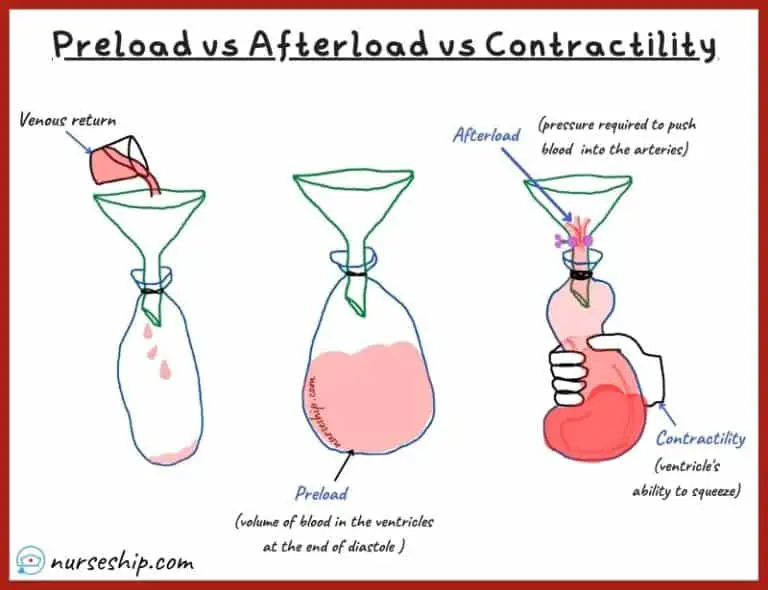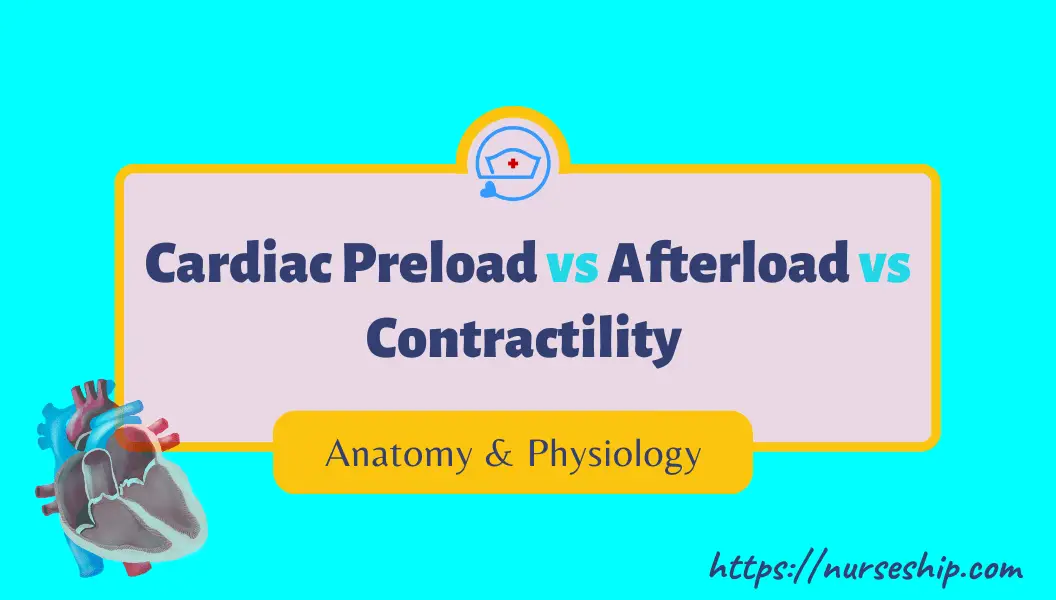
Cardiac Output and Cardiac Index Preload, Afterload, Contractility, And More Explained
Heart failure can affect your preload and afterload in different ways. Not every person with heart failure will experience these effects. According to 2017 research, the following are the most.

This is an example of preload and afterload heart hearthealth fitness body design
Heart during ventricular diastole. In cardiac physiology, preload is the amount of sarcomere stretch experienced by cardiac muscle cells, called cardiomyocytes, at the end of ventricular filling during diastole. [1] Preload is directly related to ventricular filling. As the relaxed ventricle fills during diastole, the walls are stretched and.

Cardiac Preload vs Afterload vs Contractility With an example
In this video, Dr Mike explains all the factors that contribute to cardiac output. This includes the complex terms PRELOAD and AFTERLOAD!

Cardiomyopathy Preload vs Afterload YouTube
One of the really nice things about preload and afterload is that the two have so much in common. So if you're trying to figure out afterload, then remembering what preload is about is a really good idea because the definitions are so similar. So we have volume and pressure on this graph. I'm actually going to start by sketching out very.

Cardiac Preload vs Afterload vs Contractility With an example
Cardiac output is the volume of blood the heart pumps per minute. Cardiac output is calculated by multiplying the stroke volume by the heart rate; normal cardiac output is about 4 to 8 L/min but varies depending on the body's metabolic needs. Cardiac index is a calculation of the cardiac output divided by the person's body surface area (BSA).

Difference between "PRELOAD "and "AFTERLOAD " MEDizzy
📝 Find notes here: https://www.nonstopneuron.com/post/preload-and-afterload-for-ventricles-of-the-heartExplore our entire animation video library: https://w.

Physiology Glossary Cardiac Performance (CO, SV, Preload, and Afterload) Draw It to Know It
Preload and afterload are terms you need to know for your next exam — or the next time you're taking care of a patient. So you'll likely be asked to calculate a patient's afterload and preload, along with memorizing other cardiac-related terms.. In this post, we're going to turn complicated, frustrating lectures on cardiac output into effortless, piece-of-cake study systems.

Ventricular PressureVolume Relationship Preload, Afterload, Stroke Volume, Wall Stress & Frank
Cardiac output is the amount of blood the heart pumps in 1 minute, and it is dependent on the heart rate, contractility, preload, and afterload. Understanding of the applicability and practical relevance of each of these four components is important when interpreting cardiac output values.

preload and afterload Nursing mnemonics, Nursing school survival, Icu nursing
Preload can be defined as the initial stretching of the cardiac myocytes prior to contraction. Preload, therefore, is related to muscle sarcomere length.Because sarcomere length cannot be determined in the intact heart, other indices of preload are used, such as ventricular end-diastolic volume or pressure.. When venous return to the heart is increased, the end-diastolic pressure and volume of.

PPT Cardiac Muscle Contraction PowerPoint Presentation, free download ID6530818
This wall stress is what causes the distention in the cardiac myocyte. Another definition of preload is that "preload is the pressure on the ventricular wall prior to contraction (i.e. at the end of diastole). Afterload = "LV wall stress during ejection". Unlike preload which is the wall stress at a specific point in time, the afterload.

CVS physiology lecture 11 PRELOAD vs AFTERLOAD. YouTube
How Afterload Affects Stroke Volume and Preload. As shown in the figure, an increase in afterload shifts the Frank-Starling curve down and to the right (from point A to B), which decreases stroke volume (SV) and increases left ventricular end-diastolic pressure (LVEDP). The basis for this is found in the force-velocity relationship for cardiac.

Ventricular PressureVolume Relationship Preload, Afterload, Stroke Volume, Wall Stress & Frank
PRELOAD, AFTERLOAD AND CONTRACTILITY. Preload is the initial stretching of the cardiac myocytes (muscle cells) prior to contraction.It is related to ventricular filling. Afterload is the force or load against which the heart has to contract to eject the blood. Contractility is the intrinsic strength of the cardiac muscle independent of preload, but a change in preload will affect the force of.

Difference Between Preload and Afterload Compare the Difference Between Similar Terms
Preload vs. afterload nursing review of stroke volume and cardiac output. What is cardiac preload and afterload?Cardiac preload is the amount the ventricle s.

Elements of Cardiac Function Berne and Levy Physiology, 6th ed
Also termed left ventricular end-diastolic pressure (LVEDP), preload is a measure of the degree of the ventricular stretch when the heart is at the end of diastole. Preload, in addition to afterload and contractility, is one of the three main factors that directly influence stroke volume (SV), the amount of blood pumped out of the heart in one cardiac cycle.[1] Affected by changes in venous.

Ventricular PressureVolume Relationship Preload, Afterload, Stroke Volume, Wall Stress & Frank
Afterload is largely dependent upon aortic pressure. Afterload is the pressure that the heart must work against to eject blood during systole (ventricular contraction). Afterload is proportional to the average arterial pressure. [1] As aortic and pulmonary pressures increase, the afterload increases on the left and right ventricles respectively.

Physiology of the Heart online presentation
Check out this Free Hemodynamic Value Cheatsheet To Help You Understand Cardiac https://nursing.com/cheat-sheets/Understanding Preload and Afterload is a lot.